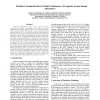Free Online Productivity Tools
i2Speak
i2Symbol
i2OCR
iTex2Img
iWeb2Print
iWeb2Shot
i2Type
iPdf2Split
iPdf2Merge
i2Bopomofo
i2Arabic
i2Style
i2Image
i2PDF
iLatex2Rtf
Sci2ools
ICPP
2008
IEEE
2008
IEEE
Machine Learning Models to Predict Performance of Computer System Design Alternatives
Computer manufacturers spend a huge amount of time, resources, and money in designing new systems and newer configurations, and their ability to reduce costs, charge competitive prices, and gain market share depends on how good these systems perform. In this work, we concentrate on both the system design and the architectural design processes for parallel computers and develop methods to expedite them. Our methodology relies on extracting the performance levels of a small fraction of the machines in the design space and using this information to develop linear regression and neural network models to predict the performance of any machine in the whole design space. In terms of architectural design, we show that by using only 1% of the design space (i.e., cycle-accurate simulations), we can predict the performance of the whole design space within 3.4% error rate. In the system design area, we utilize the previously published Standard Performance Evaluation Corporation (SPEC) benchmark n...
Architectural Design | Design Space | Distributed And Parallel Computing | ICPP 2008 | Performance |
Related Content
| Added | 30 May 2010 |
| Updated | 30 May 2010 |
| Type | Conference |
| Year | 2008 |
| Where | ICPP |
| Authors | Berkin Özisikyilmaz, Gokhan Memik, Alok N. Choudhary |
Comments (0)

